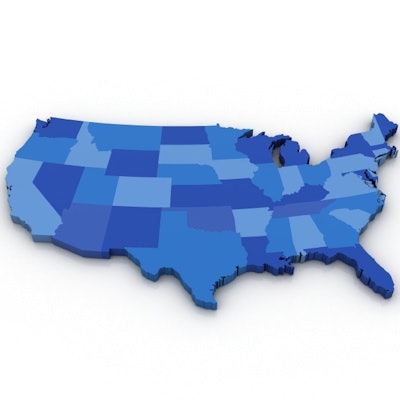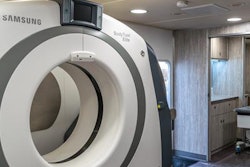
The availability of CT lung cancer screening facilities favors U.S. regions that have relatively fewer individuals at risk of lung cancer. This suboptimal distribution may be contributing to the slow adoption of screening among eligible smokers, according to an article published in the May issue of Chest.
Researchers from New York evaluated the availability of screening facilities associated with the American College of Radiology (ACR) lung cancer screening registry and uncovered clear disparities in their geographic distribution. They found that states with the greatest need for screening -- especially in the South -- tended to have the lowest density of facilities per individual at risk of lung cancer (Chest, May 2019, Vol. 155:5, pp. 900-907).
The overall increase in the number of CT lung screening facilities in the U.S. is encouraging, but their poor distribution highlights an opportunity for policymakers to better allocate resources and possibly improve lung cancer detection and outcomes, noted first author Dr. Minal Kale and colleagues from Icahn School of Medicine at Mount Sinai in New York City.
"We suspect that this distribution partly contributes to the slow adoption of lung cancer screening among eligible current and former smokers in the U.S. ... We will be unable to fully achieve the expected gains from lung cancer screening until there is improved access and referrals to high-quality lung cancer screening programs," they wrote.
Geographic variation
Despite backing from the U.S. Preventive Services Task Force (USPSTF) and numerous lung societies, participation in CT lung screening remains very low, with recent reports indicating that rates may now be even lower than before the U.S. Centers for Medicare and Medicaid Services (CMS) approved coverage for the exam.
Poor geographic distribution of screening facilities continues to be a major barrier for many eligible individuals in the U.S., especially for those living in rural regions and socioeconomically disadvantaged areas. The stipulation that exams must be performed at a comprehensive CT lung screening program associated with a CMS-approved lung cancer screening registry in order to qualify for Medicare reimbursement further limits availability of the exam.
Seeking to better understand the availability of screening services in the U.S., Kale and colleagues investigated the geographic distribution of facilities that participated in the ACR lung cancer screening registry. The registry included 3,728 facilities as of February 26, 2018.
The researchers analyzed the data using a hierarchical clustering technique that took into account each state's number of lung screening facilities, various socioeconomic factors, and lung cancer incidence and mortality. The clustering method revealed three major geographical groupings: cluster 1 (northern states plus Florida), cluster 2 (most southeastern states), and cluster 3 (southwestern states plus Washington, DC).
Overall, the researchers discovered that the southeastern states in cluster 2 had the fewest total CT lung cancer screening facilities, despite having the highest lung cancer burden. The team also found that the states in cluster 2 and cluster 3 had a significantly lower density of facilities per 100,000 individuals at risk of lung cancer than the states in cluster 1 (p < 0.002). In addition, these mostly southern states had less than half the growth rate in facility density between 2016 and 2018, compared with most northern states.
| Availability of CT lung cancer screening facilities in the U.S. | |||
| Northern states + Florida (cluster 1) | Southeastern states (cluster 2) | Southwestern states + Washington, DC (cluster 3) | |
| Average number of CT lung screening facilities per state* | 74 | 67 | 80 |
| Density of CT lung screening facilities (per 100,000 at-risk individuals)* | 6.2 | 3.8 | 2.9 |
| Increase in facility density from 2016-2018 (per 100,000 at-risk individuals) | 2.5 | 1.3 | 1.1 |
Inequality in healthcare
Although the data show gradual growth in the number of CT lung screening facilities, it remains unclear whether availability is sufficient to meet screening needs for the eligible population, the authors noted. The group also found no linear association between the number of screening facilities and lung cancer incidence and mortality, though it may still be too early to determine the statistical significance of these relationships.
"The mismatch between distribution of at-risk individuals and lung cancer screening programs is worrisome as it has potential to perpetuate and exacerbate existing disparities in lung cancer outcomes," Dr. Renda Wiener from Boston University School of Medicine and Dr. Patricia Rivera from the University of North Carolina wrote in an accompanying editorial.
To help minimize limited screening access, Wiener and Rivera proposed a temporary solution: permitting CMS reimbursement for screening exams performed at any of the more than 7,100 ACR-accredited CT screening facilities, which is nearly double the current number of comprehensive CT lung screening programs. They also emphasized the need to continue promoting effective strategies for engaging underserved individuals, who often have the highest rates of lung cancer yet the least access to screening.
"The paradox of the healthcare system in the U.S., the land of plenty, is the scarcity of resources and access to care where it is most needed. ... As [CT lung screening] becomes more widely adopted in the U.S., we must work to ensure the individuals most at risk of developing and dying of lung cancer are not left behind," they wrote.




















